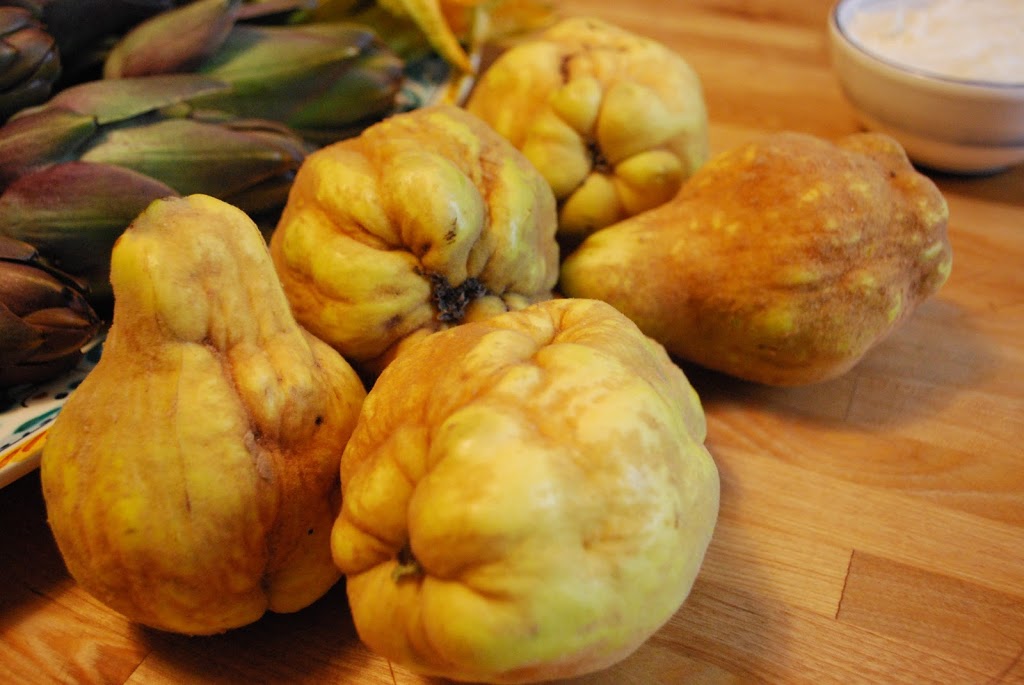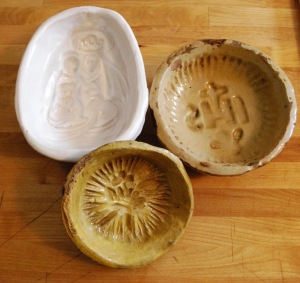
There are some fruits and vegetables that remind me of the past. Odd shapes and incredible flavor and fragrances. Quince are one of those fruits. Impossible to eat as is.
Often when at the market something catches my eye that I HAVE TO COOK. I don’t think I ever cooked or saw quince in California when I lived there, but in Italy, there are two kinds of quince, cotogna, one more of an apple shape and these that I found which are more like an ancient pear. The fragrance they gave off in the bag was intoxicating. This is an old fashioned sweet which every household used to have. Lovely with tea as a sweet or now served with pecorino cheese as a snack.
Last week I saw some and didn’t pick them up as I was working and went shopping on my day off twice and didn’t find them. So I grabbed the next quince I saw at the market this week to make Cotognata, a quince paste which is served with cheeses here. It is also known as Membrillo in Spain.
In my travels, I am also always on the look out for new food toys. When I was in Sicily I found some formine, clay bowls with designs for molding the cotognata and other fruit pastes which are also eaten as desserts. In Catania I saw the paste also made from cactus fruit, prickly pears, knows as Fichi d’India.
The molds traditionally have religious decorations, probably a hold over from the Spanish occupation of Sicily.
It is a simple recipe- like jam making and can be made darker by cooking longer-
The recipe I used was equal weight of sugar to puree and cooking until thickened, about 20 minutes.
Other recipes say cook for an hour.
I am waiting now for the paste to dry so I can un-mold it and will add the photo’s to the blog.
Cotognata
1 kilo quinces
1 kilo sugar
1 bay leaf or lemon
( basically it is equal parts of sugar to the fruit puree, so can be any amount)
Wash and peel the quinces.
Cut into chunks.
Place in pan and cover with water add the bay leaf or lemon slices for flavor.( some recipes add cinnamon)
Boil and cook until tender.
Remove from water.Puree. I used an immersion blender.
Weigh the puree.
Add the same weight of sugar.
Mix and cook to desired thickness and color.
Wet the molds with cold water ( can also use jam jars or a glass baking dish)Let sit out until dry.( you can also place in a low oven overnight. I may need to do that as it is not hot now)
Remove from molds and you can cut into slices or shapes, using cookie cutters.
You can save in a tin with bay leaves between layers or waxed paper.
If serving as a sweet, after cutting, roll pieces in granulated sugar.




We were just wondering about the two types of quince issue. I guess the ones we have growing are the pear shaped ones. Do they have different names?
In northern Italy they refer to “Melacotogne”
And “Peracotogne”. It’s as simple as that.
so interesting and love the idea of serving with cheese
I do love quince paste or quince candy!
This comment has been removed by a blog administrator.
This takes me back twenty-five or more years, to when I was a student in Sevilla, Spain. The summers were so incredibly hot, and the only things I could bear to eat were Spanish omelette, watermelon and quince. I have no idea why quince – perhaps because the sugar gave me some energy! Thanks for the memories – I need to try making this for myself.
Judy, this is wonderful. The method I made it is almost similar. After boiling and pureeing the quince, I added demerera sugar and honey. Actually the Greek method is with only honey but as Greek honey is quite expensive and I would have needed around 1 kilo, I preferred to add demerera sugar. When cooked I added fragrant geranium leaves just for five minutes to release their fragrance and added roasted almonds. I wet a pyrex with rose water and spread the quince paste. Now, I will have to wait until it dries. I was thinking of the method of the oven as today it was cloudy and windy. I love the idea that you used those beautiful molds.
Have you ever made quince spoon sweet. That is even better than quince paste.
@ivy I often just cook quinces to have with pork, in slices. or yes more as a jam. this is the first time I am using my sicilian molds
I also cook quince with pork and love it!
Quince is starting to show up in the Midwest (who knows where it comes from?) It does evoke the past and yes, next time I see it – I shall give this a twirl.
I LOVE quince! Thank you for sharing this!
Congratulations ,really delicious 😀
jocuri de gatit
Maybe i can answer a few of the questions posted? Quince originates from the Caucasus regions of Armenia, Georgia and Northern Iran. The gorgeous quinces pictured are Smyrna Quinces (now known as Izmir, Turkey). The variety was brought to the San Joaquin Valley of California in 1887. I didn’t know all these things about quince until I came across a cookbook devoted to cooking them called Simply Quince. I made Quince Salsa for quest last week and they went wild! The recipe for Quince Paste in the cookbook calls for less sugar than you used.
what a delicious jam, do you have more alternative recipes like this one?
stunning recipe! original and fresh: seems that you are a great chef! there’s no doubt about it!
I find that nice fonts can be very good for small curved lines around the shapes of the body.